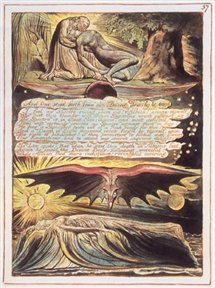William Blake, Plate from Jerusalem,
The Emanation of the Giant Albion, 1804.
Etching and watercolour.
Yale Center for British Art, New Haven.
William Blake
(London, 1757-1827)
Poet, draughtsman, engraver and painter. William Blake’s work is made up of several elements – Gothic art, Germanic reverie, the Bible, Milton and Shakespeare – to which were added Dante and a certain taste for linear designs resembling geometric diagrams, and relates him to the great classical movement inspired by Winckelmann and propagated by David. This is the sole point of contact discernible between the classicism of David and English art, though furtive and indirect. Blake is the most mystic of the English painters, perhaps the only true mystic. He was ingenious in his inner imagination, and his interpretations of ancient and modern poets reveal as true and candid a spirit as the title of his first work – poems he composed, illustrated and set to music, Songs of Innocence and of Experience. Later he achieved grandeur, power and profundity, especially in certain tempera paintings. Like others, Blake was considered an eccentric by most of his contemporaries, until his genius was recognised in the second half of the nineteenth century.
Blake was born in Soho in London, the city in which he lived his whole life – excepting a brief period spent in Sussex – and which influenced his ideas of good and evil. He left school at the age of ten to attend the Henry Pars Drawing Academy. At fifteen he finished his education at the academy, and became apprentice to the engraver James Basire. Blake’s official profession was that of an engraver; it is said that he could not afford an apprenticeship to a painter. Painting and writing he did for pleasure. His apprenticeship lasted six years, after which he joined the Royal Academy of Art. He opened his own shop in 1784, and it was just prior to this that his friends paid for his poems to be published in a volume called Poetical Sketches; Blake had been writing poetry since the age of thirteen. The title demonstrates the uniting of different arts, here poetry and drawing, that was a fundamental feature of Romanticism. In his later publications, Blake illustrated his poems with evocative and sometimes almost grotesque imagery, aided by his wife Catherine Boucher, whom he married in 1782. Blake was preoccupied with ideas of good and evil, which was manifest in his work. He hated slavery and abhorred the conditions and inequality of eighteenth-century London life, which he described in his illustrated poem London.
Blake died in 1827 at the age of sixty-nine. After his death and that of his wife, some parts of his work, both writing and imagery, that were deemed too political, heretical or sexual were destroyed or erased by various parties.
